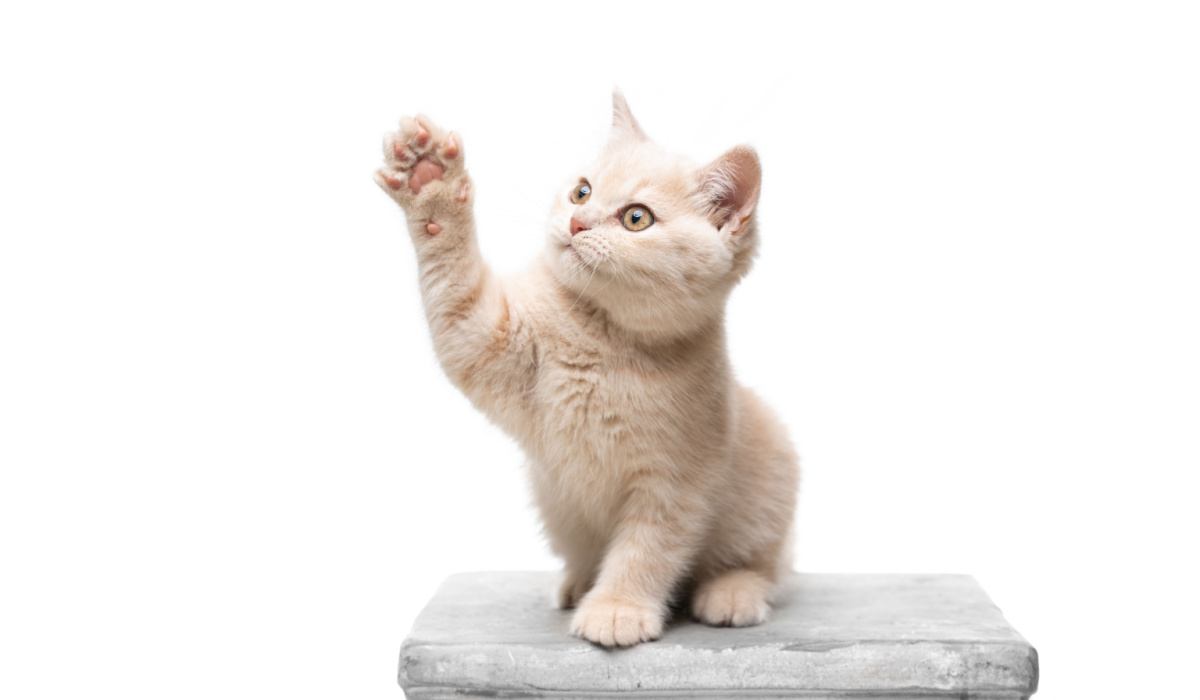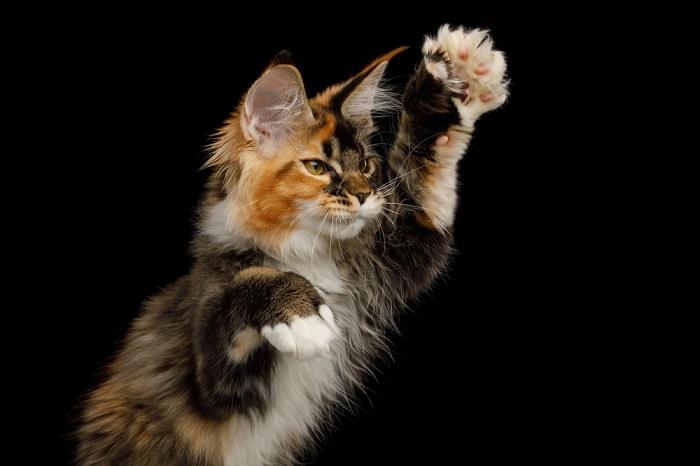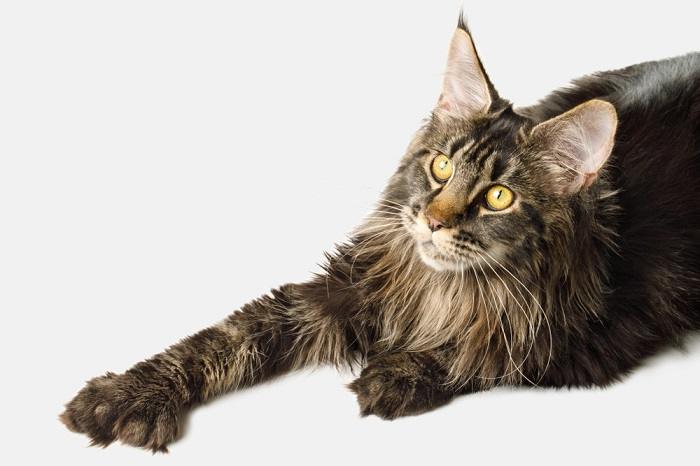
Have you ever inspected your cat’s toes and marveled over how cute they are? Perhaps you’ve noted that they have a different number of toes on their front paws compared to their back paws. If you haven’t, you might want to have a look next time your precious feline is curled up near you, as quite a few pet cats actually have extra toes!
Most cats have 18 toes, 5 on each front foot and 4 on each hind paw.
Polydactyly is a genetic condition that causes cats to have variable numbers of extra digits. Less commonly, syndactyly causes the fusion of toes together, resulting in a smaller number of digits. Polydactyl cats are common, and the trait is not harmful.Key Takeaways
The majority of cats have 18 toes: 5 on each of the front feet, and 4 on each of the hind paws. However, a genetic abnormality called polydactyly leads some cats to have some sneaky extra digits! Read on to find out more about this harmless condition – and remember to check your kitty’s feet!
What Polydactyl Cats Are

While polydactyly in cats is a genetic abnormality, it is completely harmless.
Polydactyly is a congenital physical abnormality in cats, causing them to be born with more than the usual number of toes on some of their paws. Polydactyly comes from the Greek, meaning ‘many digits’, and is a genetic mutation that can affect cats of any breed, sex, or size.
The condition is caused by a dominant gene, meaning that if even one parent cat has the gene, up to 50% of their kittens may also be affected. Polydactyly causes a varying number of extra toes, but the front paws are more commonly affected.
Is Polydactyly Common?

Once upon a time, polydactyl cats were considered good luck, so this trait has been passed on through genetics.
Cats with extra digits are actually fairly common. Due to the genetic link, there are clusters of affected cats in some areas geographically. The Maine Coon breed is particularly affected, with the condition reasonably common in these gentle giants of the feline world.
Historically, polydactyl cats were thought to bring good luck. This superstition was particularly prevalent amongst seafarers, who would often bring cats with extra toes aboard as ship cats. As well as their good luck, they were also considered to be excellent mousers – a useful trait to prevent rodents from eating all the food on the ship. Cats were popular seafaring companions, as they were even thought to be able to predict the weather.
It is known that English sailors brought some of these special cats overseas on their ships. Thos cats then mated with unaffected cats, passing the dominant gene down to their offspring. This explains the higher populations of polydactyl cats in England, Wales, Canada, and the Boston area of the United States compared to the rest of the world.
The author Ernest Hemingway was given a polydactyl cat by a friend of his, who happened to be a ship’s captain. The captain’s cat was called ‘Snowball,’ and he gave one of its kittens, a polydactyly, to Hemingway. The author named it ‘Snow White’ and was extremely fond of it. Because of this, Hemingway gained a love of cats with extra toes.
Snow White was allowed to breed, and a large population of her descendants still live at the Hemingway home in Key West, Florida – many of which have varying numbers of extra digits. The famous author’s well-known love for this abnormality has led to some people referring to six-toed cats as ‘Hemingway cats’!
Another famous polydactyl kitty was Slippers, a six-toed feline who lived in style at the White House, as he was owned by the then-president, Theodore Roosevelt.
Also Read: 150 Best Polydactyl Cat Names: Unique Ideas For Cats With Extra Toes
Are Extra Digits Bad for Cats?

Having multiple toes can be an advantage to cats living in rough terrain.
Polydactyly is a genetic mutation, but a harmless one. The life expectancy of a cat with extra digits is the same as an unaffected cat. Generally, the extra digits are merely a quirky feature for those affected cats. If the extra digits are formed mid-cat paw, they can resemble thumbs – although obviously not opposable ones!
This is why some people refer to polydactyl cats as ‘thumb cats’ or ‘mitten cats’. The extra digits can appear in varying numbers and locations but are not usually thought to cause any problems.
In fact, those who live in certain environments, such as Maine Coon cats in their snowy state, may actually find the larger paws help them to navigate harsher terrains. The wider, larger paws could theoretically provide extra stability when climbing, hunting, and jumping.
The extra toes are usually completely normal. In occasional cases, the extra toe is incompletely formed, and the nail can then become ingrown or overgrown, requiring careful attention.
Polydactyly should not be confused with feline radial hypoplasia. This is a condition that involves a poorly formed, shortened radial bone, leading to deformities in the front limbs.
Also Read: Radial Hypoplasia In Cats: Causes, Symptoms, and Treatment
How Many Extra Toes Can Cats Have?

Cats with extra toes were thought to be good mousers and were welcome aboard ships to keep mice out of the food supply.
Polydactylism can cause a varying number of extra digits, with the front paws more often affected. It is fairly uncommon for all four paws to have extra toes, but it does happen. In fact, the Guinness World Record for most toes on a cat is held by a Canadian tabby called Jake, who has 7 toes on each of his four paws – 28 in total!
Caring for a Polydactyl Cat

The only real issue that a polydactyl cat may have, is the need to have their claws more frequently trimmed.
Cats with extra toes don’t generally need different care from any other cat. It is useful to get into the habit of checking your cat’s claws regularly, as they may need trimming. The dewclaw can get especially long as it is not worn down as the cat moves around.
Scratching posts are recommended for all cats, as felines are highly motivated to scratch. As well as sharpening their claws, scratching is a form of territorial communication in cats, due to pheromones released from their foot pads. Polydactyly cats have extra claws, and so can do a lot of damage to floors and furniture if not provided with an appropriate scratcher!
Also Read: 8 Best Cat Nail Clippers
Cats With Fewer Toes

The normal number of toes in a cat is 18, and cats with polydactyly can have more than this. There is an opposing condition to this, called syndactyly, or split foot, where the cat has one or more toes that are fused together. This is much more common on a front foot than a back foot. A subtype of this condition is called ectrodactyly, or ‘lobster claw’, where the paw is split down the middle, with fused toes on either side forming the look of a pincer.
This condition is much rarer than polydactyly but also does not seem to impede the cats’ movements or cause any pain or distress. Occasionally, the claws of the fused toes grow in odd directions and need regular clipping.
Also Read: 12 Warning Signs Your Cat Is In Pain And Crying For Help
Cat Toes: Summing Up

Most cats have 18 toes in total, but an interesting genetic condition called polydactyly can result in extra digits. These cats appear throughout history and various populations exist globally. The extra digits don’t tend to cause any harm, but some may need more frequent trimming. The opposite of polydactyly is syndactyly. This is where some toes fuse together, so the cat appears to have a claw or pincer. These many-toed cats were once thought to be good luck. Who knows? Maybe you have yourself a lucky polydactyl cat as well!
Also Read: How To Take Care Of A Kitten: The Complete Guide
Frequently Asked Questions
What breed of cat has six toes?
Most cats have 5 toes on the front paws and 4 on the back paws. If your cat has 6 toes, they have a genetic condition called polydactyly. This can occur in all breeds but was especially prominent in the Maine Coon.
Why do cats have 6 toes?
Cats should have 5 toes on the front paws and 4 on the back paws. If your cat has 6 toes on any paw, they have a genetic mutation called polydactyly. This causes a variable number of extra digits in cats and is generally a benign condition.
Can cats have four toes?
Most cats have four toes on their back paws, although they generally have five on their front feet. If your cat only has four toes on its front paws, it may have syndactyly, a condition where some toes fuse together.
Why do cats only have four toes?
Cats only have four back toes, compared to five on their front paws. This may be because their hind limbs are required mostly for power and speed, rather than to catch onto things as the front claws are.







